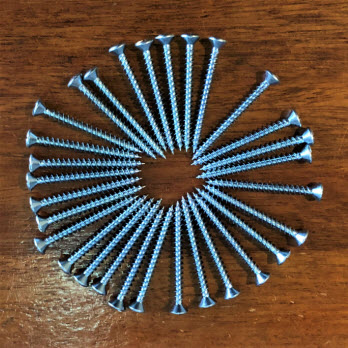Shed security screws: Which type is best?
Using shed security screws is one of the easiest ways to improve the security of your shed. If you search for shed security screws you will find a vast array of different types of wood screw heads and materials. In this article I hope to give you an appreciation of the different types of security screws that are available. I'll also give you my opinion on which is the best type of screws to use in a shed door and why.
As part of my work I build, repair and dismantle sheds, so I get to see many different approaches to shed security as well as repairing the occasional shed after a break-in. In the dismantling work I also get to practice removing bits of hardware and trying different methods of breaking and entering into a garden shed!
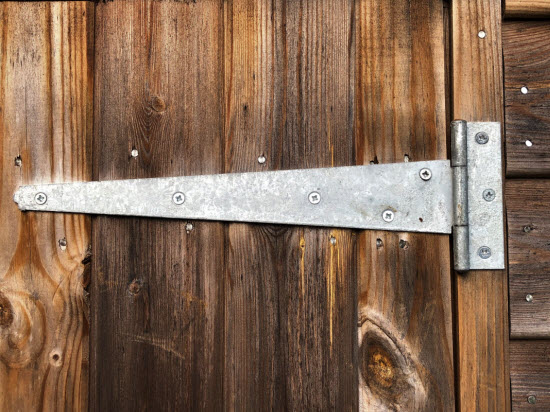 Shed hinge installed with standard posidrive -screws - These can be very easily undone!
Shed hinge installed with standard posidrive -screws - These can be very easily undone!
What are the main variables for shed security screws?
There are three different combinations that can be found for wood security screws:
Material: Stainless vs steel
Head type: Countersunk vs button head
Security type: Pin hex vs one way
Material: Stainless vs steel
The advantage of stainless steel is its appearance and resistance to corrosion. Most stainless steel screws have a lovely satin appearance and they are much more resistant to rust, especially important for outdoor use and when using pressure treated wood.
The downside of stainless steel is that it is weaker than the hardened steel that is used in regular external grade screws. This is apparent in manufacturer information and I have found this out through personal experience. When driving in stainless steel screws I frequently strip the cross heads on posi screws and snap the head off the smaller diameter screws. My concern is that it would be easier for an intruder to break or snap stainless steel screws using a pry bar than equivalent standard external grade wood screws.
The outcome of this is that in locations where I consider security more important than appearance steer away from using stainless steel.
Head type: Countersunk vs button head
Button head screws tend to be used in softer material. The flat area under the head of the screw acts to clamp the item being installed, with the larger area under the screw head indenting the material beneath less. However if you are face mounting steel items, such as shed door hinges, having a protruding head such as a button head is relatively easy (if a bit noisy) to remove using a cold chisel and hammer. Also the holes on most good quality shed door hinges are countersunk.
The countersunk head is made to be inserted into a countersunk hole. The countersunk screw fits into this hole with the flare of the head bearing against the face of the metal. This makes the head of the screw flush and difficult to remove using a grinder or hammer. For this reason I think that the countersunk head is a better option security wise.
Security type: Pin hex vs one way
When it comes to security head screws there are two philosophies;
Screws where it is possible to remove them with special tools
Screws that are just extremely difficult to remove, period.
The screws that need special tools are generally based around the Torx or 6 lobe type screws. This type of screw is much less widely used than the ubiquitous Philips or cross head screw. The Torx screw is then made even more niche by leaving a small pin of material in the middle of the screw head. This means that it can only be removed using a torx head bit with a little hole left in the middle to accommodate the pin.
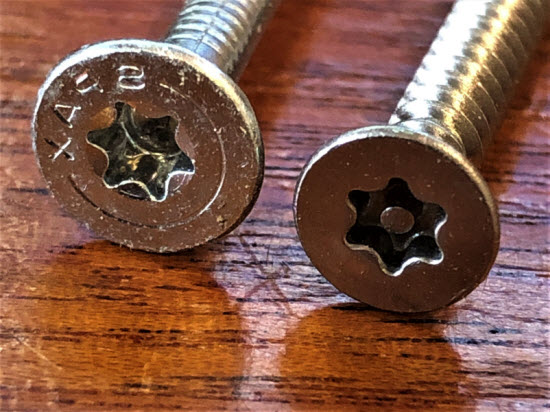 A standard Torx head screw on the left. The Torx Security screw, on the right, has a pin in the centre
A standard Torx head screw on the left. The Torx Security screw, on the right, has a pin in the centre
Both torx head and torx pin head bits are generally available but they form a much less common part of tool kits than the average Philips screwdriver. So both types of screw are removable but classed as tamper-proof security screws given that the average person might not be aware of the different types of bit available.
The second type of screw is the type that is simply very difficult to remove. These have a specially designed head so that the screw can be tightened using a flat head screwdriver. But if you try to remove it, the screw head is designed such that the screw driver will just slip out. There are methods to remove this type of screw but they are noisy, messy and time consuming.
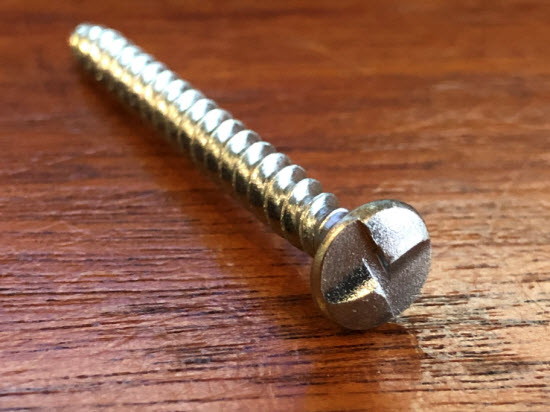 Close up of one way screw head. This is tightened with a standard screw driver, but can only be turned clockwise. The head design means that it can't be undone!
Close up of one way screw head. This is tightened with a standard screw driver, but can only be turned clockwise. The head design means that it can't be undone!
A well-prepared intruder may have the right bit to remove a torx or torx pin screw but if they come across a one way type screw they will look for another way to gain entry (or hopefully another shed!)
To summarise the above before we look at an example
My preference given the above variables would be to use an exterior grade countersunk screw with a one-way head.
One way screws can be difficult to source from hardware stores
I have taken the liberty of buying a load of one-way screws in bulk and have them for sale here.
They should be the right size for most shed doors, they are 5mm dia and 50mm long.
I believe they are an effective way of improving the security level of an existing or new shed.
|
One Way Shed Security Screws £8.50 (UK Only)
|
Securing a shed hinge shed security screws
The vast majority of shed hinges, are on the outside of the door and supplied with standard posidrive (cross head) screws. A potential thief with a very minimal tool kit can easily remove the screws to get into the shed.
There are two ways to get over this problem
Method one - security hinge and coach bolts
The shed security hinge has one of the holes enlarged on the door side and one on the door frame side of the hinge. The standard hole size for a shed hinge is 5mm which will accommodate a 5mm (No. 10 size) wood screw. On a security hinge this hole has been enlarged to 8mm to accept an 8mm diameter, dome head, square neck coach bolt.
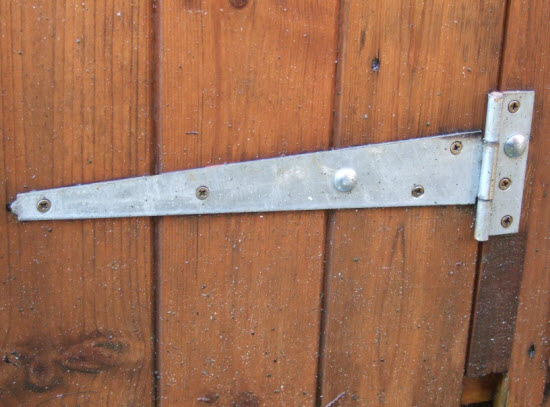 Shed security hinge installed with 2 coach bolts
Shed security hinge installed with 2 coach bolts
As you can see from the picture there is no way of undoing this bolt from the outside, the smooth bolt head can only be removed by undoing the nut on the inside of the door. This method really improves the security of the shed.
Note: shed hinges are made of two sections as you can see in the sketch below. The two sections of a hinge are joined by a hinge pin. On cheaper hinges the hinge pin can be easily driven out with a hole punch or screwdriver (even easier than removing the screws). Make sure that you have higher quality hinges where the pin isn't easily removable.
Method two - is to use one of the many types of security wood screw
The second method is to use shed security screws. Although each screw individually is smaller than the coach bolt. The intruder has to remove all of them on one side or other of the hinge to gain entry to the shed. This method has the advantage that you don't need any special tools and is an easy way to improve security without the requirement for any special tools.
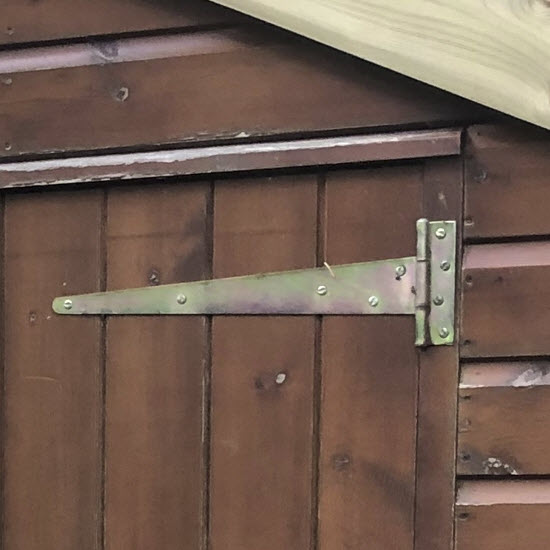 Strap hinge installed using one way shed security screws
Strap hinge installed using one way shed security screws
How to install one-way shed security screws
To install one-way security screws I recommend that you install standard screws first. This means that you have the shed door hung in a way that it swings cleanly and that the lock works well. Then remove the standard screws one by one and replace them in turn with a one-way screw, using the screw hole from the screw just removed. This method will avoid you having to find ways to remove the one way screws if the door doesn't swing true on first attempt!
Practical example
The shed in the picture below belonged to a customer. It was a shed containing garden equipment, lawn mowers and power tools at the end of a long garden. An intruder gained entry to the garden and their first attempt was to gain access via the shed windows. However, after removing the trim around the window they saw that it had window security bars. First attempt foiled!
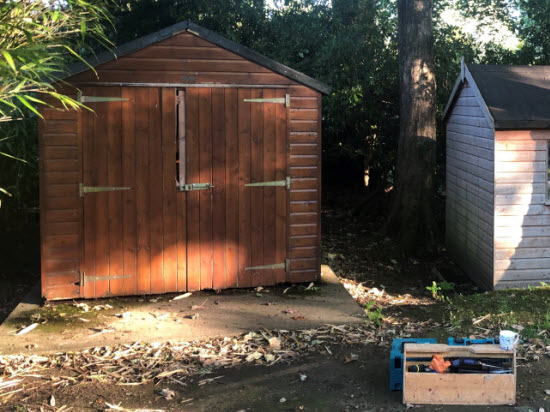 Shed after break-in
Shed after break-in
They then turned their attention to what they perceived as the next weak point, the wooden door of the shed. The door had the hinges fixed using one-way security screws so the next avenue of attention was to physically remove the shed cladding adjacent to the door lock and undo the barrel bolts inside the double door.
As these were quite determined thieves they then managed to force the doors open to gain entry to the inside of the shed.
Lessons learned
The example shows that intruders will try several methods to bypass security measures and gain entry. Also that the shed security screws played their part and were effective in deterring attack.
After the burglar made his getaway I was called in to make repairs. We discussed the problem and the main potential areas of weakness as well as solutions such as security cameras and shed alarms. We agreed that for the type of equipment stored that a maximum security type of approach wasn't appropriate.
After considering the main potential areas of weakness we decided that the best way forward was to add a shed security bar would provide an acceptable level of security.
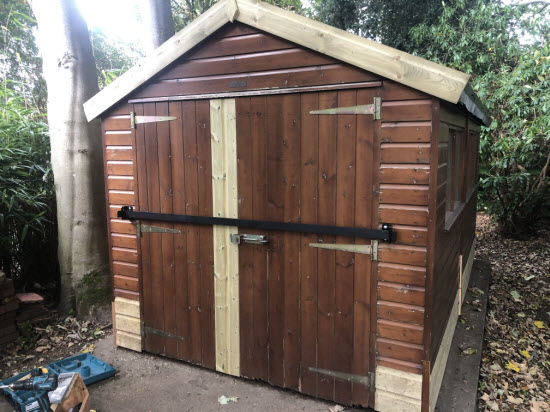 Repaired shed after break in
Repaired shed after break in
Having a security bar would have prevented the intruder from his ultimate method of entry. Would it have prevented the burglary or just directed his attention elsewhere?
For other methods of improving shed security see the shed lock page.
To order one-way security screws suitable for three shed hinges see below:
|
One Way Shed Security Screws £8.50 (UK Only)
|

Looking for more information on how to get your shed door working perfectly?
Return from Shed Security Screws to the Shed Door Hardware hub page

Keep in touch with our monthly newsletter
Shed Building Monthly
